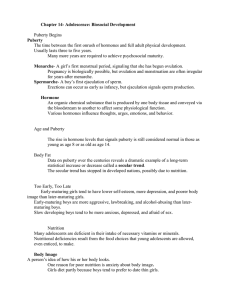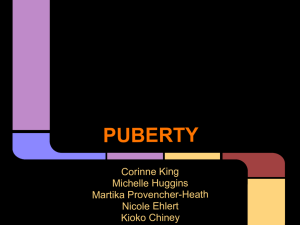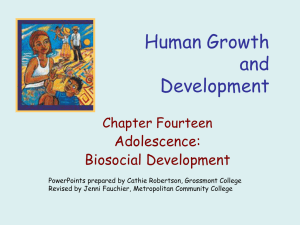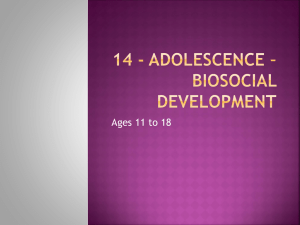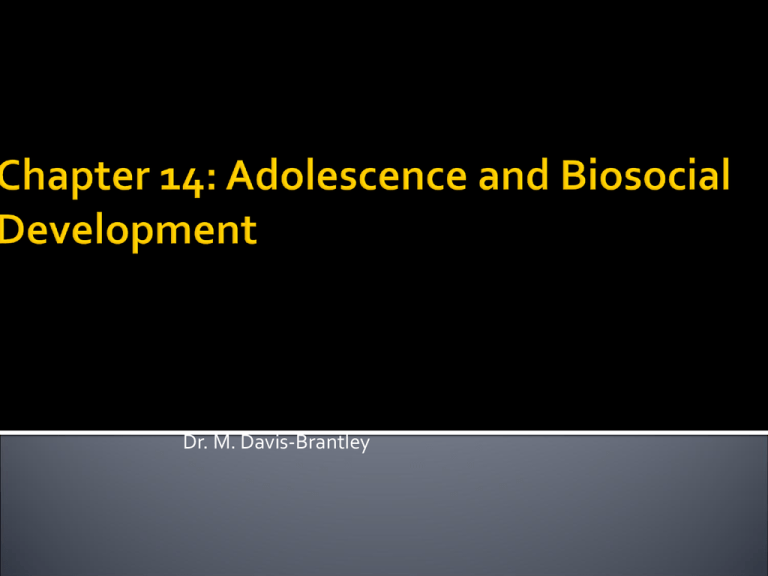
Dr. M. Davis-Brantley
Adolescence-is the period of biological, cognitive,
and psychosocial transition from childhood to
adulthood, usually lasting a decade or so
Puberty-is a period of rapid growth and sexual
change that occurs in early adolescence and
produces a person of adult size, shape, and sexual
potential
Girls
Ovaries increase production of
estrogen/progesterone (9)
Uterus and vagina begin to grow (9 ½)
Breasts begin to appear (10)
Pubic hair begins to appear (11)
Weight increase (11)
Widening of hips due to muscle and
organ growth (12)
Menarche (12 ½)
Full breast growth (18)
Boys
Testes increase production of testosterone (9
½)
Testes and scrotum grow larger (10)
Pubic hair begins to grow (11 ½)
Penis growth begins (12)
Spermarche (first ejaculation)(12 ½)
Peak height spurt (13)
Peak muscle and organ growth, shoulders
become broad (14)
Voice lowers (14)
Visible facial hair appears (15)
Hormones are responsible for all aspects of growth and development and are
controlled by the hypothalamus
Pituitary Gland
Responds to signals from the hypothalamus to produce growth hormones and regulate
growth
Adrenal Glands—secrete hormones
Gonads—are the first parts of the body to enlarge at puberty because they
produce hormones as well as gametes (sperm and ova)
Hypothalamus regulates maintenance activities (eating, body temp.) and directs the
production of hormones
Female gonads are ovaries
Male gonads are testicles
Estrogen—Sex hormone secreted in large amounts by females
Testosterone—Sex hormone secreted in large amounts by males
Remember:Both genders produce both sex hormones
See Figure 14.1 on page 343
Timing is easy to notice: Girls begin puberty ahead of boys
Video: GIRLS vs BOYS
As early as 10 years old, some girls begin to develop breasts, whereas boys
can take up to age 17 to begin developing
Girls tend to be 2 years ahead of boys in development
Menarche is the first menstrual period, which occurs between ages 9 and
15 (average:12 years old)
Spermarche is the male’s first ejaculation (harder to pinpoint in time)
Body fat: Onset of puberty correlates with weight
Menarche does not usually occur until a girl weight about 100 lbs.
Primary Sex Characteristics are the sex organs that are involved in
reproduction includes vagina, uterus, ovaries, testicles, and penis
During puberty, every primary sex organ becomes much larger
Females: Ovaries and Uterus grow, and the Vaginal lining thickens
Males Testes grow and the penis lengthens and the scrotum enlarges and
becomes pendulous (hangs loosely)
Secondary Sex Characteristics are body characteristics that are not
directly involved in reproduction but that indicate sexual maturity, such
as a man’s beard or woman’s breasts
Females: Slight rise around nipples, budding breast
Males: Areola develops, larynx (Adam’s apple)
Sexually Transmitted Diseases/Infections
Teenage Pregnancy
Pregnancy occurring within 1-2 years after menarche can result in increase risk of
spontaneous abortion, high blood pressure, stillbirth, Cesarean section, etc…
The body is not yet prepared to handle a pregnancy
Women who have given birth under age 16 tend to be shorter, sicker as adults, and die
at younger age
Babies of young mothers have more birth and growth complications. They experience
more mistreatment and it can result in less academic achievement
Sexual Abuse
Sexual Abuse is the use of an unconsenting person for one’s own sexual pleasure. Sexual
activity is abusive whenever it is not mutual, whenever consent is not freely given, or
whenever a person does not understand or feels obligates to agree to a sexual
encounter
Child sexual abuse is any activity in which an adult uses a child for his/her own sexual
stimulation or pleasure—even if it does not involve physical contact. Child pornography,
fondling, and lewd comments by strangers are all examples of child sexual abuse
Drug use—the simple ingestion of a drug
Drug abuse—the ingestion of a drug to the extent
that it impairs the user’s biological or psychological
well-being
Drug addiction—A situation in which a person
craves more of a drug in order to feel desired
physiological or psychological effects
“Gateway drugs”


